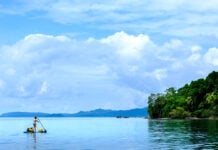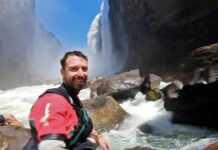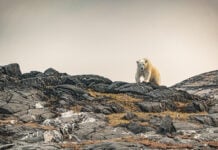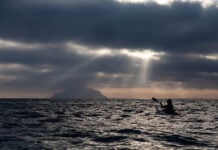Dad and I lie dead still in the dark tent, listening to a grizzly grunting outside. The old half-joke that, “You don’t need to outrun the bear, just the person next to you,” isn’t as reassuring when you’re both rolled up in sleeping bags like a pair of bear burritos. I ease the bear spray out of a pocket and flick the safety off. Minutes crawl by, but eventually, we hear heavy footsteps plodding away.
We’re not on tonight’s menu.

Tide & teeth: Inside four months kayaking the Inside Passage
Morning is welcome but bitterly cold. A pair of bald eagles chirrup on their nest as we warm our hands on bowls of porridge. It’s early May, and we’re camped in Icy Strait, the northernmost link of the Inside Passage, a 1,000-mile stretch of islands and inlets that shield southeast Alaska and Canada’s west coast from the brunt of the Pacific’s swell. If all goes to plan, we have four months of sea kayaking ahead of us, zigzagging south towards Victoria, British Columbia. Today is day three, and last night was our first bear. The first of many.
After breakfast, we haul the kayaks down the beach. The pebbles are scattered with snow, and the peaks opposite are smothered in it. An unseen avalanche rumbles in the distance as we stand by the water’s edge, watching our breath fog as we brush our teeth. But the rising sun breaks through the low cloud, and we can imagine that we’re warm as we launch onto shining water.

Stormbound
Two weeks later, we’re huddled in a sodden tent. Outside, it’s raining so hard that the air is basically water. Small fish could swim into treetops if they tried. The cove we’re camped in is small, steep, and full of bear tracks. By recent standards, this is a pretty good spot. A few days ago, we ended up rigging a bivvy on a tiny, exposed island while a pair of oblivious grizzlies patrolled the opposite shore, just a short swim away for a hungry bear.
I poke my head out of the tent to check the paddling conditions. The wind is hauling sheets of spray off the sea and whirling them into the rain. We’re not going anywhere today. On the bright side, it’s a good time to be stuck. A few days ago, Dad tripped on a root and twisted his dodgy knee. Lying white-faced on the ground, he began to insist that he was fine but gave the game away by swearing.
Dad never swears, so he was obviously in agony.
An experienced paddler, Dad retired early to make this trip on the basis that you never know how long you’ll stay fit, particularly when you’re turning 60. I decided sharing the adventure was worth quitting my job for, a choice that somehow resulted in me being given a sabbatical.
We were ready to go. Then COVID paused everything for two years. At the start of the third year, Dad was kayaking near home when a rogue wave slammed him into a shallow gully. He escaped with a dislocated shoulder, and then a month later, I dislocated my shoulder climbing, and the trip was off again. A friend suggested that the universe might be trying to tell us something.
Once our shoulders had recovered, Dad got back into training, while I moved to rural India for my partner’s PhD fieldwork and lost whatever paddle fitness I had left, just in time for us to finally set off. So, despite a more than 30-year age gap, we’ve ended up on a pretty equal footing: Dad grimacing whenever he bends his leg, and me grimacing whenever I lift my paddle.
The next day we pull on our wet kit in the dark and launch at dawn, even though Dad can’t put weight on his bad leg and there’s serious whitewater offshore. Unsurprisingly, we retreat at the first headland. We set the tent up wetter than before and spend the rest of the day trying to sleep.
The following day, the weather hasn’t calmed. We eat porridge in the rain, then get back in the tent to read and sleep, sleep and read… BOOM! We shove our heads out, just in time to see falling spray hit the water. A humpback is breaching in our cove! It launches again… WHAM! Then starts tail slapping, WHAM! WHAM! WHAM! I sprint down to the water’s edge in nothing but my boxers. The whale does a final body slam and then glides off.
The world is full of omens, so pick the ones you like. The wind drops overnight.

Bears and ‘bergs
We’ve now been kayaking for over a month, and we’ve got used to bears wandering past in the night. I suspect we sleep soundly through most visits, although tonight’s bear came too close for comfort, snuffling at the tent edge directly behind our heads. We both sat up slowly in our sleeping bags, but we were grinning in the dark.
Today will be our second attempt at paddling through Dry Strait, a sprawling tidal sandflat at the mouth of the Stikine River. We tried yesterday, setting off into a building wind that eventually slowed us to a standstill. We got out and hauled the kayaks for a while, plodding along the edge of a mudflat with the boats bobbing behind on tow lines and fresh bear tracks between our feet. It was great fun, but we weren’t getting anywhere fast, so we clambered back in and let the wind blow us back to our previous camp spot.
The wind is light this morning, and we make it through the strait with no issues. We’re rewarded with icebergs, and they’re more than worth the two-day effort. Every crack and recess glows with the bluest blue imaginable. Otherworldly blue. Luminous blue. The blue all blues want to be when they grow up.
The first berg we reach is as big as house, and even though we can’t remember the exact ratio, the currents whirling around the base remind us that it’s many times bigger below the water. Dad hangs back while I go for a closer look. The surface is studded with frozen bubbles that crackle as they burst in the sunlight, but I don’t have much time to admire the effect because a choppy undercurrent drags me behind an overhang, and I have to paddle hard to escape.
As soon as I’m clear, Dad goes in for a look. I take photos while he gets caught in the exact same current. Once he’s out, I hand over the camera and head in for round two. I’ve just made it back to Dad when the iceberg implodes. The overhang crashes down first, then the whole thing rears up in the water, flips over, and disintegrates. We sit in thoughtful silence for a moment. Later, we paddle past more icebergs and discover that they collapse often. Lesson learned.
Close encounters
After two months, we’re nearing the Canadian border. Technically, we’re not even halfway done yet, but the remotest and roughest paddling is behind us. We’ve both recovered from the aches and sprains of the first month, we’re on schedule, and even hauling heavy kit between the kayaks and our camps has eased from a grinding slog into a mediative ritual. But our new, comfortable rhythm does come with a downside. For the first time on the trip, whole days can feel mundane.
This morning, even the weather is boring—a flat grey sky over a flat grey sea, and the only wildlife we’ve spotted all morning are herring, thousands of them, flashing silver in the murky water. Then, from the distance, we hear whale spouts. I spot the black fins before Dad does.

The orcas are a long way off, but they’re headed our way. They’re following the coast like us, staying close, with the herring shoals. We raft up. It’s a moment we’ve been hoping for since before we began the trip, but now there’s fear mixed in with the excitement. Orcas don’t hunt humans, but that comforting fact doesn’t change the immediate truth—we’re a pair of bobbing bath toys, and there’s a pod of super predators cruising towards us.
Also, I’ve seen what they can do to a seal.
It’s a big pod, strung out into three groups. Four adults up front, trailing a calf that keeps jumping and bumping. Then, another group, maybe five adults, and finally, two massive bulls at the back, with fins taller than I am.
They’re passing parallel to us, close but not too close, and we briefly wonder if they haven’t spotted us. Then they pause and cluster up. We can hear them breathing at the surface. One makes a loud farting noise that echoes across the water, which is quite funny but not reassuring. Perhaps it’s a signal. Either way, they know we’re here.
Two adults break off from the group and start to swim in our direction. They’re moving slowly at first, then they slide out of sight beneath the surface, and I notice my hands are shaking. There’s a heartbeat’s pause before they surge back up, accelerating hard and half-breaching, their massive heads bulldozing whitewater. It feels like we’re trying to sit calmly in the middle of a motorway with a couple of lorries racing at us. They dive hard just before they reach us, then come up suddenly on both sides, blowing hard and making the boats rock in their wake. They dive again, so close they almost hit us, and I feel a strong urge to lift my bum off my seat as they pass under the kayaks. I look down and there’s an orca rolled on its side, staring straight back at me.
The next thing we know, the rest of the pod has joined in. There are orcas everywhere: behind us, under us, around us—it’s impossible to keep track of them all. The noise is incredible: blowholes snort, fins slap, and bodies splash. They dwarf us, but they’re unbelievably precise, passing under our kayaks within a finger’s width but never touching. Eventually, one by one, they move off.
I turn to Dad. We’ve both got our mouths open. I try to say something, but my voice keeps cracking, and I give up.

Southbound
That evening, we have to make a tricky landing onto sea-slick boulders. A lone humpback glides past in the shallows while I stand waist-deep in the water, unloading the kayaks.
Tomorrow, we’ll paddle across an invisible line, out of Alaska and into Canada. The last two months were full of aches, pains, hunger, and hard paddling, but looking back, it feels like we moved effortlessly from one incredible encounter to another: paddling through a flock of sea ducks as wide as the horizon, singing sea shanties to an unimpressed bear blocking a narrow portage point, watching the bulbous nostrils of a humpback clamp shut as it dived within a kayak’s length of us.
The rose-tinted glasses get stronger as time passes. The exhaustion will fade, the perpetually soaked gear will become a footnote, and by the time we’re home, Dad will be insisting Alaska was warm the whole time.
Oli Broadhead is a documentary photographer, filmmaker and writer. Find a day-by-day account of his journey at @oli_broadhead.
Dramatic skies during a crossing to the mainland. | Feature photo: Oli Broadhead












 This article was published in Issue 73 of Paddling Magazine.
This article was published in Issue 73 of Paddling Magazine. 






This article reminds me of a cartoon I saw decades ago titled, “The Devolution of Humans.” It showed a line of evolution before the devolution starting with a sea creature crawling from the sea, then developing legs, then evolving into an ape, then into a Neanderthal and then modern man before beginning the devolution, which was depicted as a kayaker. I am an avid whitewater canoeist at 77 years old, but I am ALWAYS quick to assess the limits of my skills and physical ability, as well as the river conditions I will be paddling. You can only push the envelope so far before it pushes back. These guys were lucky that the griz were not hungry!